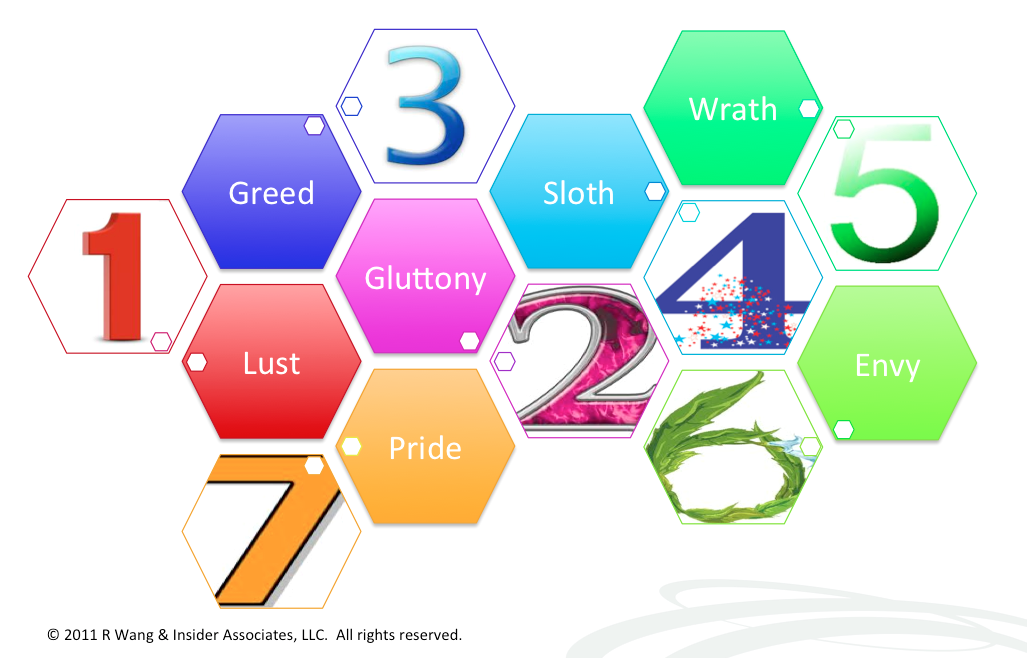
Best Practices: Applying The Seven Deadly Sins To Successful Gamification

The Seven Deadly Sins Draws On The Dark Arts
Conversations with game designers and gamification experts over the past month highlight how important design should appeal to the human spirit. Intrigue, reward, status, community, and challenge drive 5 key areas of engagement. However, some of the masters of gamfication have revealed some dark arts that touch on connecting with human psychology to engage (see Figure 1). One approach is applying the seven deadly sins. Strategies on adopting the seven sins can be summarized as:
Figure 1. Applying The Seven Deadly Sins To Gamification
- Lust appeals to lack of self control and attraction. Engage the user through intrigue. Find what attracts the user through incentives.
- Gluttony refers to excess, over-consumption, and over-indulgence. Focus on the desire to accumulate, acquire, and contribute.
- Greed calls on the desire for power, status, and wealth. Use non monetary incentives such as immediate recognition to drive engagement. Provide scarcity in rewards.
- Sloth attracts laziness, indifference, and complacency. Keep designing the system to be uber convenient for the user. Privacy falls aside when convenience wins out.
- Wrath calls out anger, impatience, revenge, and rage. Draw on the desire for immediacy. Reward for rapidity.
- Envy fuels a need to desire what others have. Highlight the success of others. Improve transparency on the spoils and rewards.
- Pride draws out vanity and narcissism. Foster healthy competition. Incentivize the pursuit of excellence.
The Bottom Line: Reward Alignment Of The Seven Deadly Sins With Non Monetary Incentives
A study of best practices show a number of non-monetary incentives that can drive success (see Figure 2). Three key non-monetary areas include:
- Level 1: Recognition. This first level focuses on highlighting success and engaging novices. The key themes drive personal brand recognition.
- Level 2: Access. This second level builds demand for association and attracts intermediate users. Non monetary incentives create value and scarcity around access to resources, people, and tools for improvement.
- Level 3: Impact. This third level appeal to power users and advanced users. At this level, bragging rights and incentives align with impact to the organization.
Figure 2. Non Monetary Gamification Incentives
Your POV.
Designing your gamification models? Have you tried applying the seven sins? Have you tested out the 3B’s (i.e. Badgeville, Bigdoor, and Bunchball? Ready to here how you can apply the white arts of the 7 Virtues to work? Add your comments to the blog or send us a comment at r (at) softwareinsider (dot) org or info (at) ConstellationRG (dot) com.
Related Resources
20110120 Trends: 5 Engagement Factors For Gamification And The Enterprise
Reprints
Reprints can be purchased through Constellation Research, Inc. To request official reprints in PDF format, please contact [email protected].
Disclosure
Although we work closely with many mega software vendors, we want you to trust us. For the full disclosure policy, stay tuned for the full client list on the Constellation Research website.
Copyright © 2011 R Wang and Insider Associates, LLC All rights reserved.
 R "Ray" Wang
R "Ray" Wang R "Ray" Wang
R "Ray" Wang